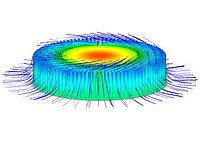
Photo from wikipedia
Abstract Using a gradient-based optimization method, an optimal mass distribution for a single-walled carbon nanotube (CNT) is determined for extremal thermal conductivity. The variation of atomic mass distribution or the… Click to show full abstract
Abstract Using a gradient-based optimization method, an optimal mass distribution for a single-walled carbon nanotube (CNT) is determined for extremal thermal conductivity. The variation of atomic mass distribution or the isotope impurity in the CNT could lead to either extremely high or low thermal conductivity. The adjoint variable method is employed for the efficient and accurate design sensitivity analysis of thermal conductivity, which can be obtained from non-equilibrium molecular dynamics (NEMD) approach. The obtained analytical sensitivity can be extensively utilized to determine the optimal distribution of atomic masses, using a density-based topology optimization method. The resulting thermal conductivity is reduced by more than 90% or increased by 70% of the one of the pristine CNT. The density of states (DOS) after the optimization indicates that the optimization process yields the effective and physically meaningful result as we interpret the resulting distribution of mass.
Journal Title: Computational Materials Science
Year Published: 2018
Link to full text (if available)
Share on Social Media: Sign Up to like & get
recommendations!